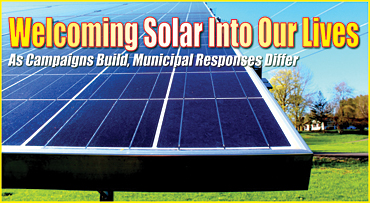Serving the Towns of Wawarsing, Crawford, Mamakating, Rochester and Shawangunk, and everything in between | |||
| |||
|
Thank You So Much, Dear Readers, For Your Continued Support! Read more...
Welcoming Solar Into Our Lives
As Campaigns Build, Municipal Responses Differ
REGIONAL – Solar power is shifting from a rarity to not only commonplace but the new normal. This process offers great opportunities and some hefty challenges. Enter Solarize Rondout Valley, one of many Solarize efforts at work across the state that's pressing for more residential and commercial solar projects. And with it comes Community Distributed Generation, an even newer concept. "We are a non-profit, community-centered campaign," explains John Wackman, spokesman for Solarize Rondout Valley. "What Solarize does is simplify decision making and serve as a liaison between homeowners seeking solar arrays and installers." The basic thrust of the program is to save money for those buying into solar with a group purchase discount that taps into the state's incentive funding. Installers are carefully selected, and customers are assured of only getting high quality components. Meanwhile, NYSERDA's "Affordable Solar" program, tied to Solarize efforts, doubles the usual state incentive for qualified homeowners. There are Solarize groups all across New York state. Communities in the Rondout Valley that have joined the campaign include Rochester, Marbletown and Olive, and among the installers selected for the area are Lighthouse Solar of New Paltz, whose sales manager, Matt Calardo, filled in many of the details for us. "Solarize is there to help people take advantage of the incentivized environment right now, because solar is subsidized at this point. That isn't going to last forever," Calardo explains. "The systems we install are stable, the technology is mature, and remember that there are no moving parts in a solar array. There are even 25 year warranties on the inverters so primarily this is to have outreach to more potential customers and then demystify the process." First, though, some basics: only one in four homes here have roofs that are suitable for solar arrays, meaning they have southern exposure and are big enough. Then there's the question of how much an installation will affect one's electrical bill. "We need to see how much electricity is being used and break out what the components of that might be," Calardo continues. "We go down to the basement and there's a full electric water heater... that's probably your biggest usage right there, might be 5000 kw hours a year. Did you know you could replace it with a hybrid heat pump water heater, and cut that to 2000 kw hours a year? The hybrid might be priced at $1,000, but there's a Central Hudson credit for $450 and a $300 federal tax credit, too, which cuts the price to about $250 with a huge saving over the year." If your roof won't work, you can go for a ground mounted array. "Fortunately in this area many people have pretty big lots, so there's often some room for an array," Calardo says, before pointing out how one could also add in an electric car... "Say you commute to Albany in a Tesla. When you get home you recharge the battery," he adds. "That can take 50 kw hours every night and the average usage here is about 35 kwh a day." Patterns of electricity usage are in flux, and huge changes are coming. Calardo notes that among other things the grid infrastructure will have to be given a boost. If large numbers of people are recharging electric cars every night then the somewhat scanty power line network in our area will have to be upgraded. In the meantime, start thinking about where you will charge your cars: workplaces with charging stations will become a priority and homeowners with solar arrays will have a natural advantage in this burgeoning situation, though the grid will still need upgrading. "The large national installers are losing ground," Calardo observes. "The model is changing." Towns are passing local laws to govern the process, trying to leave homeowners free to put solar on their roofs, but seeking to regulate what property owners might put in a field as the focus for towns and commercial installations shifts to the bottleneck of obtaining connection to the grid. Calardo offers some interesting benchmarks. "The average home installation is just 7 kilowatts. State funding covers up to 25 kw," he says. "When you get over 300 kw, for a large installation, the utility company requires a $40,000 engineering CESIR study." That's where you run into "the queue," because there are hundreds of commercial projects, many speculative, waiting for connection permits. Which may never happen. Part of this last issue has to do with local circuits, many installed long ago, that have only just so much capacity and can be easily overwhelmed by new projects. Which is the issue that Larry DeWitt and Carl Chipman of Rochester are trying to get ahead of as they ready their town's proposal for a solar array on the old dump at the town's transfer station. There's also rumor of a huge potential change in the game. Installers are seeing allusions to a mechanism that would allow the benefit of electricity generated here, say, to be transferred outside the Central Hudson zone to benefit customers elsewhere. In other words, the possibility of a much larger "free market" in community power. In the heavily regulated field of electric power generation that would be a real revolution. Meanwhile Solarize community meetings and workshops begin this month. Kickoff events for Solarize Rondout Valley take place on April 30 (look it up on Facebook or read these pages next week). And the first standard community workshop takes place in the Olive Free Library on May 6. Talk about a perfect Earth Day phenomenon for all of us!
Copyright © 2017, Electric Valley Media LLC | Terms of Use
All Rights Reserved. |
|
|||||||||||||||||||||||||||||||||




